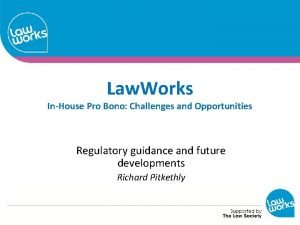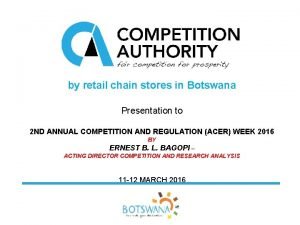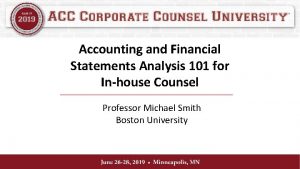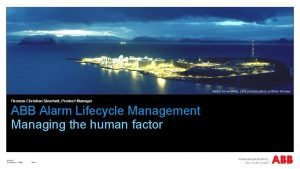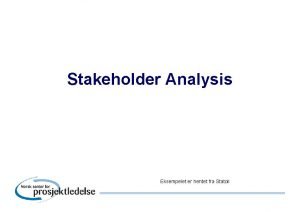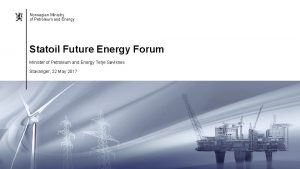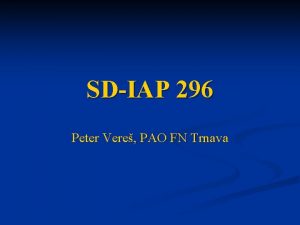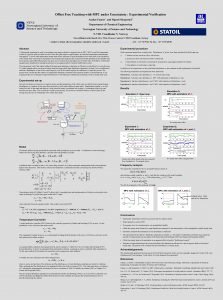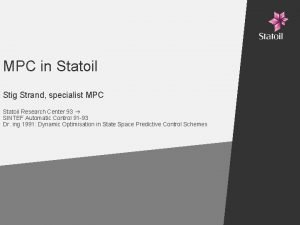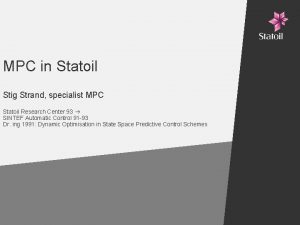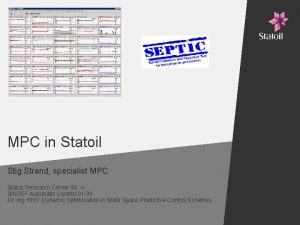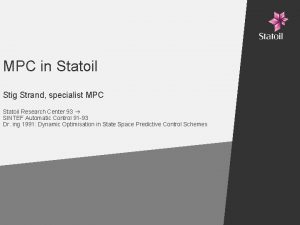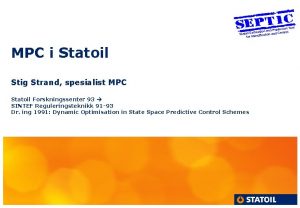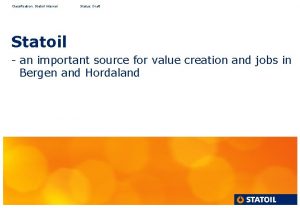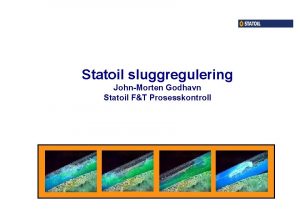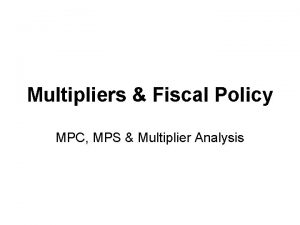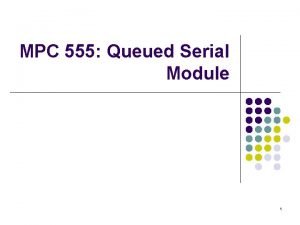MPC in Statoil 2 MPC in Statoil Inhouse











- Slides: 11

MPC in Statoil

2 MPC in Statoil • In-house tool Septic, Statoil Estimation and Prediction Tool for Identification and Control • Developed and maintained by the process control group in the Research Centre (from 1996). • Principal developer: Dr. Stig Strand • C++ code, runs under Windows, VMS, Unix • First application at Statfjord A in 1997 to increase process regularity • 72 MPC/RTO applications with Septic within Statoil • Experimental linear step response models, built-in functionality for model scheduling • Non-linear models are currently used in 6 applications. • Flexible control priority hierarchy • Quality control by inferential models built from laboratory data or on-line analysers

#8 (2008) HNO Åsgard #3 Norne Heidrun Snøhvit Aug-07: 72 installasjoner Mongstad Kollsnes Tampen Gullfaks #25 #3 #2 #25 Kårstø #14 Kalundborg 3

4 MPC applications in Statoil • Oil refining (Mongstad and Kalundborg) – Distillation columns – Product blending (gasoline, gas oil) – Cracking, reforming and hydrotreating – Heat exchanger network (RTO) – Multi-unit optimisation (RTO/DRTO) • Gas processing (Kårstø, Kollsnes, Snøhvit) – Distillation – Gas quality control – Pipeline pressure control – Optimisation • Offshore production – Extended slug control – Crude blending – Production optimisation

5 Why MPC? How can we benefit from improved control? By reducing the variance , the setpoint can be moved closer to its specifications

6 Contributions of MPC • Improved process response to feed variations Planning Scheduling • Improved product quality control • Maximise capacity, maximise profit, reduce cost • Respect process constraints related to equipment or (RTO, DRTO, MPC) (hours) environment Supervisory Control • (days, weeks) Real Time Optimisation model based multivariable control Increased process regularity (MPC) (minutes) Basic Control (DCS) (PID, FF, . . ) (seconds) Basic Control MPC RTO – DRTO - MPC

7 MPC variables • Controlled variable (CV) – Set point, high and low limits (constraints) • Manipulated variable (MV) – High and low limit, rate of change limit, ideal value (desired, set point) – Acts normally on a basic PID controller set point • Disturbance variable (DV) – Measurable, affects the CVs Set point Controlled variable, optimized prediction Manipulated variable, optimized prediction Current t Prediction horizon

8 MPC solver DV Set point Controlled variable, optimized prediction Manipulated variable, optimized prediction Current MV u v CV Process model y t Prediction horizon • MV blocking size reduction • CV evaluation points size reduction • CV reference specifications tuning flexibility set point changes / disturbance rejection • Soft constraints and priority levels feasibility and tuning flexibility CV soft constraint: y < ymax + RP 0 <= RPmax w*RP 2 in objective

9 MPC Solver - Control priorities 1. MV rate of change limits 2. MV high/low Limits 3. CV hard constraints (”never” used) 4. CV soft constraints, CV set points, MV ideal values: Priority level 1 5. CV soft constraints, CV set points, MV ideal values: Priority level 2 6. CV soft constraints, CV set points, MV ideal values: Priority level n 7. CV soft constraints, CV set points, MV ideal values: Priority level 99 Sequence of steady-state QP solutions to solve 2 – 7 Then a single dynamic QP to meet the adjusted and feasible steady-state goals

10 MPC – nonlinear models l Open loop response is predicted by non-linear model – MV assumption : Interpolation of optimal predictions from last sample l Linearisation by MV step change – One step for each MV blocking parameter (increased transient accuracy) l QP solver as for experimental models (step response type models) l Closed loop response is predicted by non-linear model l Iterate solution until satisfactory convergence

11 Implementation • • • Operation knowledge – benefit study? or strategy? MPC project Site personnel / Statoil R&D joint implementation project (MPC computer, data interface to DCS, operator interface to MPC) MPC design MV/CV/DV DCS preparation (controller tuning, instrumentation, MV handles, communication logics etc ) Control room operator pre-training and motivation Product quality control Data collection (process/lab) Inferential model MV/DV step testing dynamic models Model judgement/singularity analysis remove models? change models? MPC pre-tuning by simulation MPC activation – step by step and with care – challenging different constraint combinations – adjust models? • Control room operator training • MPC in normal operation, with at least 99% service factor • Benefit evaluation? • Continuous supervision and maintenance • Each project increases the in-house competence increased efficiency in maintenance and new projects
